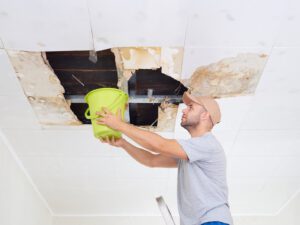Many home emergencies can be caused by water damage. A clogged toilet, a dishwasher line that has backed up, a sump pump failure or sewer backup are all potential sources of water damage. Standing water can cause significant damage to flooring, drywall, and furniture. Water can also cause mold to grow in the earliest stages, which can spread throughout the entire home. Water Damage Restoration has the equipment for removing water, drying the affected area, and sanitizing the area.

Professionals in water damage restoration will use specialized personal protective gear and cleaning products to remove standing water and other materials. Once the water has been removed, the restoration team will restore the home to its pre-damaged condition. Once the job is complete, damaged materials will be repaired or replaced. The restoration project may be minimal or extensive. Water damage restoration experts will provide you with all of the necessary assistance to recover from your disaster. You can also seek out a junk removal service to remove and dispose of the debris.
When hiring a water damage restoration company, you should ask about their experience, equipment, and insurance. Ensure that they have trained technicians and are IICRC certified. Check whether the company has an emergency phone line and is available round the clock. Always check references and ask previous clients about the quality of services provided by a water damage restoration company. Typically, online reviews will provide you with this information. If you cannot find many references for a given company, you can look for one that has been in business for more than seventy years.
While it may be tempting to try to restore the home yourself, you should seek the help of a professional to do the work for you. These professionals use equipment such as dehumidifiers, disinfectants, and ozone generators to help your home recover from water damage. There are some things you can do to help prevent future water damage, including adding additional ventilation, choosing floors made of moisture-resistant materials, and choosing paints and drywall that are resistant to water damage.
Regardless of the source of water damage, it can be a challenge to restore your home. The first step in water damage restoration is to assess the damage. Water mitigation services are intended to contain the damage to the smallest extent. These services may prevent further damage by removing excess moisture and humidity. Water mitigation services may be used to prevent a flood or basement flooding, but these solutions only help to protect the home for the moment and may not be enough. Once the mitigation process has been completed, the restoration process must begin.
The damage caused by water can be very severe. The damage can be permanent if you wait too long to call for water damage restoration. You may even need to relocate temporarily until the water damage restoration professionals can make the necessary repairs. However, if you wait for too long, you risk causing irreparable damage to your home. A professional will quickly assess the damage and get the water removed from your property. When this is complete, you can expect your home to be restored to its original condition.
There are different categories of water damage, each containing its own set of hazards. The categories determine what type of water needs to be remedied. Category one water is relatively harmless to handle, while gray water is slightly contaminated and can be cleaned by the homeowners. If the water is black, it may pose a health risk to residents. It is therefore imperative to call a water damage restoration company right away. It is important to know what type of water you’re dealing with since this will determine how much water needs to be removed.
After removing water, you must dry the affected area to prevent mold growth. A fan can help with the drying process, as can a large-capacity dehumidifier. While this won’t prevent the growth of mold, it will certainly reduce the damage to your home. If the water is in the ceiling, you’ll need to repair it immediately, and unsealed drywall and wood must be replaced as soon as possible.